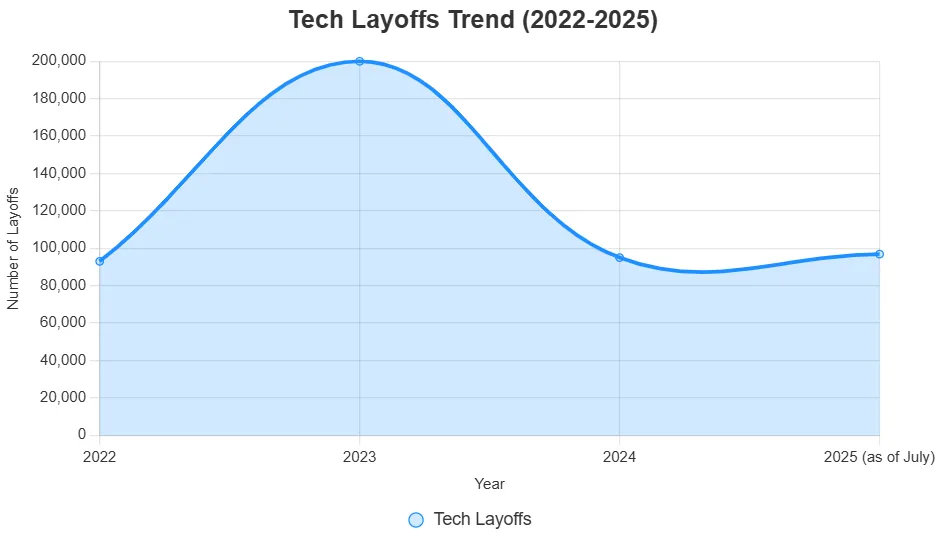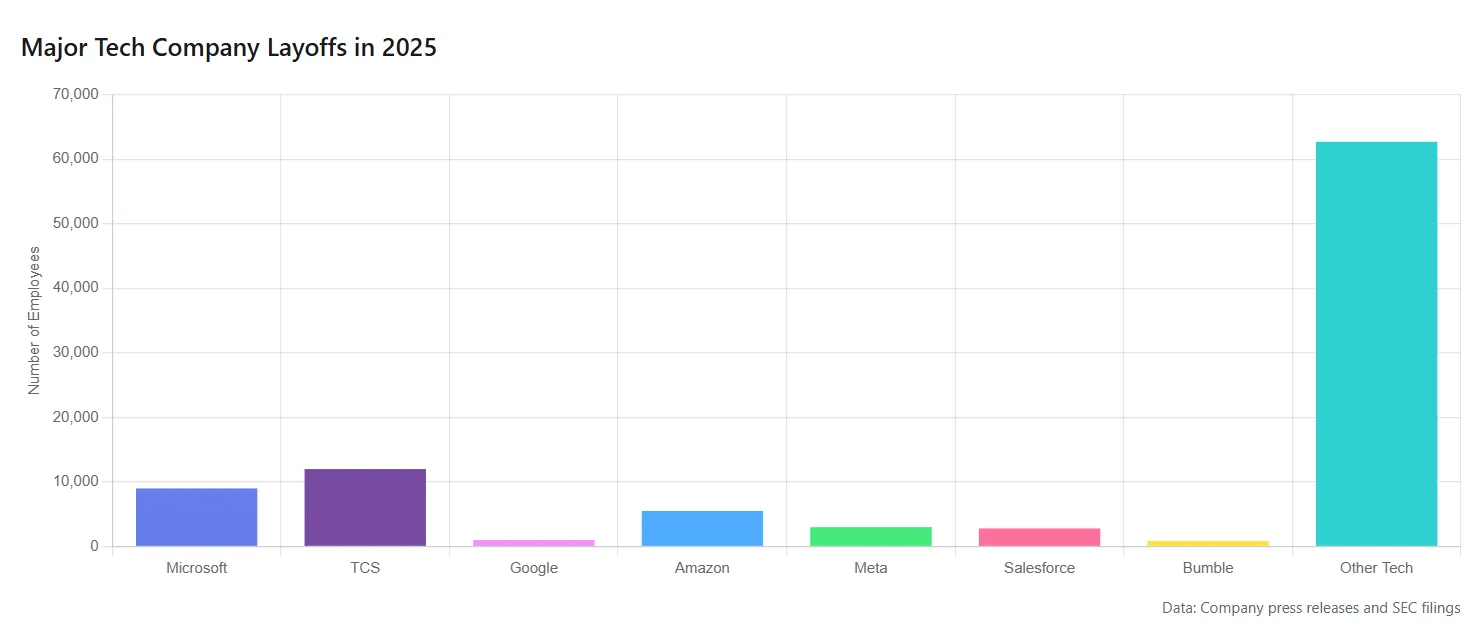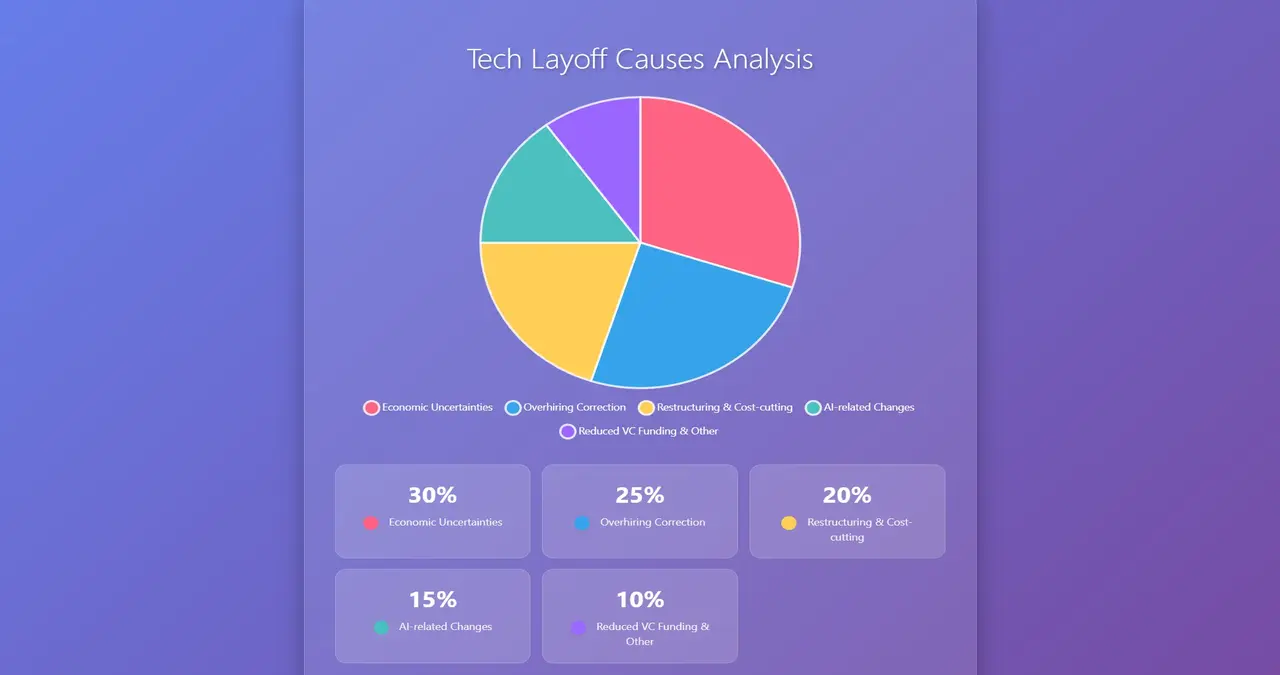According to TrueUp, the tech industry is going through a massive wave of layoffs in 2025, with more than 96,000 people losing their jobs by July 28. People often say that artificial intelligence (AI) is the main reason for these job cuts, but the truth is much more complicated. The current labor upheaval is just as much, if not more, the result of economic uncertainty, overhiring during the COVID-19 pandemic, and strategic restructuring efforts.
This article looks at the many reasons why tech layoffs in 2025 are on the rise, using data, expert opinions, and company statements to give a complete picture of the forces that are changing the tech workforce.

The Scale of Tech Layoffs in 2025
The tech industry has been having a hard time with layoffs since 2022. Firing workers.According to fyi, about 93,000 tech workers lost their jobs in 2022. In 2023, this number rose to about 200,000. In 2024, there were a few less layoffs, which brought the total down to about 95,000.
TrueUp said that by July 28, 2025, 413 layoffs had affected 96,861 tech workers around the world. Trading Economics says that the U.S. unemployment rate was 4.1% in June 2025, which means that job cuts could be as bad as or worse than in previous years, even though the economy as a whole is relatively stable.

The chart above shows how tech layoffs have changed from 2022 to mid-2025. This shows that the industry is still having trouble. The data shows that layoffs are not a new thing; they are part of a larger cycle of change in the tech sector.
Key Reasons for Tech Layoffs Beyond AI
While AI is transforming the tech landscape by automating specific tasks, it is not the sole or even primary driver of layoffs in 2025. There are a number of other important reasons for the job cuts:
1. Economic Uncertainties
Things like geopolitical tensions and policy decisions that aren’t always clear make the world economy unstable in 2025. For instance, President Donald Trump’s unpredictable plans for tariffs have made things even more unclear, which has changed how tech companies invest and run their businesses.
According to Ruyu Chen, a Stanford researcher, “The overall economic environment could also be a factor, marked by uncertainties heightened by President Donald Trump’s erratic tariff plans”. Because of economic uncertainty, businesses have had to be careful when cutting costs, even if it means laying people off.
2. Post Pandemic Correction
During the COVID-19 pandemic, tech companies quickly hired more people to meet the growing need for digital services like e-commerce platforms and remote work tools. When things got back to normal, a lot of companies had too many employees.
Chen further explained, “Many companies also became bloated during the pandemic, and recent layoffs could still be trying to correct for overhiring”. Companies like Salesforce and Google have cited this as a reason for downsizing, according to Crunchbase News.
3. Restructuring
A lot of tech companies are making significant changes to their structures to make them more efficient and profitable. This often means combining teams, making management structures less hierarchical, or hiring outside companies to do tasks that aren’t necessary.
Microsoft, for example, stated, “We continue to implement organizational changes necessary to best position the company for success in a dynamic marketplace”. Similarly, Bumble cut approximately 240 jobs to “enhance operational efficiency and allocate savings to new products and technologies”.
4. Reduced Venture Funding
Startups, which are an essential part of the tech ecosystem, are having a hard time getting funding. Venture capital investment has dropped a lot since it peaked in 2021. This has forced many startups to lay off workers to make their money last longer. Crunchbase News reports that seed and early-stage startups are particularly vulnerable, with layoffs aimed at preserving cash amid a complex funding landscape.
5. Financial Performance Issues
Some companies are struggling to meet growth or revenue expectations, leading to layoffs as a cost-saving measure. For example, Intel said it would lay off up to 25,000 workers worldwide (15% of its workforce) to save $10 billion by 2025, after losing $1.6 billion in the Q2 of 2024. Chegg also cut its staff by 21% after not meeting its financial goals.
Major Tech Layoffs in 2025 and Their Stated Reasons
| Company | Number of Layoffs | Reason (Besides AI) |
|---|---|---|
| Microsoft | 9,000 | Organizational changes for market success |
| Intel | Up to 25,000 | Cost-cutting following $1.6 billion Q2 2024 loss |
| Meta | 3,600 | Performance-based cuts, restructuring |
| Atlassian | 150 | Reduced support needs due to platform enhancements |
| Bumble | 240 | Enhance operational efficiency, allocate savings to new products/technologies |
| ~75 (Smart TV division) | Strategy adjustment, not AI-specific | |
| Consensys | 47 | Push toward profitability |
| Zeen | Unknown | Challenges in building user base and achieving long-term growth |

Expert Insights
Experts across the industry have emphasized that AI is not the sole driver of layoffs. A report from Challenger, Gray and Christmas found that “AI may be more of a scapegoat than a true culprit for layoffs: Of more than 286,000 planned layoffs this year, only 20,000 were related to automation, and of those, only 75 were explicitly attributed to artificial intelligence” (Forbes). This means that other things, like economic pressures and changes in strategy, are more critical.
Dr. Sarah Chen, an economic analyst, said that layoffs are a sign of a “deeper restructuring” caused by changes in the industry, not just the use of AI. Similarly, a laid-off Microsoft employee remarked, “This is what happens when a company is rearranging priorities,” pointing to broader strategic realignments rather than AI alone (Forbes).
Company Statements
Tech companies have been careful to say that their layoffs are necessary for business reasons and not just because of AI-driven automation:
- Microsoft: “We continue to implement organizational changes necessary to best position the company for success in a dynamic marketplace” (Forbes).
- Atlassian: Laid off 150 roles in customer service and support due to “enhancements to platform and tools [that] reduced support needs” (Yahoo Finance).
- Google: Downsized its smart TV division by 25%, stating it was adjusting its strategy, not specifically due to AI (The Information).
- Bumble: Cut jobs to “enhance operational efficiency and allocate savings to new products and technologies”.
Visualizing the Layoff Trends
The chart above shows the tech layoffs from 2022 to mid-2025. It shows that the number of layoffs peaked in 2023 and stayed high in 2025. A pie chart could also show the reasons for layoffs, based on the best data we have:

- Economic uncertainties: ~30%
- Overhiring correction: ~25%
- Restructuring and cost-cutting: ~20%
- AI-related: ~15%
- Reduced venture funding and other factors: ~10%
A bar graph comparing layoffs by major companies (e.g., Microsoft: 9,000, Intel: up to 25,000, Meta: 3,600) would further highlight the scale and variation across the industry.
Implications for the Tech Industry
The 2025 tech layoffs signal a period of significant transition. AI is changing some jobs, but the bigger factors—economic uncertainty, overhiring corrections, and restructuring—show that businesses are getting used to a post-pandemic world and a more competitive market. This shows how important it is for workers to learn new skills in areas where there are a lot of jobs, like AI, cybersecurity, and cloud computing.
The World Economic Forum predicts that tech jobs in big data, fintech, and AI could double by 2030, offering a silver lining for those who adapt (Business Insider).
For companies, the challenge is to balance cost-cutting with innovation. Overzealous layoffs risk losing talent critical to long-term success, as some experts warn that companies may regret slashing jobs prematurely (Fortune). The tech industry must navigate this delicate balance to remain competitive in a rapidly evolving landscape.
There are a lot of things going on that are causing more tech layoffs in 2025, and AI is just one of them. Experts and company statements agree that economic uncertainty, hiring too many people during the pandemic, and strategic restructuring are all big reasons.
Tech workers and businesses can get ready for the future better if they understand these trends and focus on being adaptable, learning new skills, and coming up with new ideas. The ability to deal with these problems will decide who does well in the next era of technology as the industry keeps changing.
Also Read This : How to Make Money Using AI in 2025: 25 Best ideas
Also Read This : Zuckerberg Just Declared War in the AI Arms Race: Meta Is Building Superintelligence


